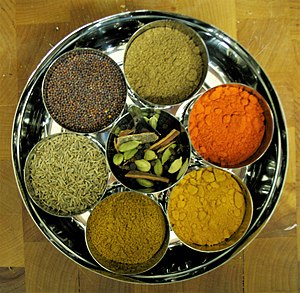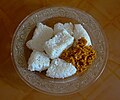南アジア料理
South Asian cuisine/ja

南アジア料理には、現在のバングラデシュ、インド、モルディブ、ネパール、パキスタン、スリランカといったja:南アジア諸国、そして時にはブータン王国やアフガニスタン首長国も含む伝統的な料理が含まれる。デシ料理とも呼ばれ、インド亜大陸以外のアジア料理にも影響を与え、また影響を受けてきた。
主食と一般的な食材

チャパティという平たいパンは、インド亜大陸の多くの地域で一般的な食事の一部である。他の多くの料理の主食には、米、アタ粉で作られたロティ、豆類などがある。
この地域の料理は、様々な種類の唐辛子、黒胡椒、クローブ、その他の強いハーブやスパイス、そして風味付けされたバターであるギーで味付けされている。生姜は、この亜大陸の料理では、風味豊かな料理にも甘い料理にも使うことができる食材である。刻んだ生姜は肉と一緒に炒められ、生姜のピクルスはよく炊いたご飯に添えられる。生姜汁やシロップで煮た生姜はデザートを作るのに使われる。ウコンとクミンはカレーによく使われる。
一般的な肉には、ラム、ヤギ、魚、鶏肉、そして牛肉が含まれる。牛はヒンドゥー教で特別な位置を占めるため、インドでは他の南アジア料理に比べて牛肉は一般的ではない。牛肉の禁止は、ある程度(水)水牛やヤクの肉にも及ぶ。豚肉は、すべてのムスリムにとってタブーな食べ物とされており、多くのヒンドゥー教徒にはタブーではないが避けられている(ただし、北東インドやゴアなど一部の地域では一般的に食べられている)。乳製品を使った非常に甘いデザートも、インド亜大陸の料理には多く見られる。インド亜大陸のデザートの主な材料は、煮詰めた牛乳、挽いたアーモンド、レンズ豆の粉、ギー、砂糖である。キールは乳製品ベースのライスプディングで、一般的なデザートである。
歴史
この亜大陸の多くの食べ物は、5000年以上にわたって知られてきた。インド亜大陸の北西部に定住したインダス文明の人々は、カメやワニを狩っていた。彼らはまた、野生の穀物、ハーブ、植物も採集していた。インダス時代(紀元前3300年~1700年頃)の多くの食べ物や食材は、今日でも一般的である。それらには、小麦、大麦、米、タマリンド、ナス、キュウリなどがある。インダス文明の人々は、油、生姜、塩、青唐辛子、そして乾燥させてオレンジ色の粉にしたウコンの根を使って調理していた。
インドの人々は、歴史を通じて葉物野菜、レンズ豆、ヨーグルトやギーなどの乳製品を使ってきた。また、クミンやコリアンダーなどのスパイスも使用した。インド原産の黒胡椒は、紀元400年頃には頻繁に使われていた。ギリシャ人はサフランをもたらし、中国人はお茶を紹介した。ポルトガル人とイギリス人は、紀元1700年以降に赤唐辛子、ジャガイモ、カリフラワーを普及させた。1200年以降にインドに到着し始めたムガル人は、食を芸術と見なし、彼らの料理の多くは25種類ものスパイスを使って調理されている。彼らはまた、ローズウォーター、カシューナッツ、レーズン、アーモンドも使用した。
18世紀後半から19世紀初頭にかけて、スコットランドのロバート・リンゼイの自伝には、シレット人のサイード・ウラーという男性がリンゼイの家族のためにカレーを料理したことが記されている。これはおそらく、イギリスにおけるインド料理の最も古い記録である。
-
Bhang eaters from India c. 1790. Bhang is an edible preparation of cannabis native to the Indian subcontinent. It has been used in food and drink as early as 1000 BCE by Hindus in ancient India.
-
A page from the Nimatnama-i-Nasiruddin-Shahi, the book of delicacies and recipes. It documents the fine art of making kheer.
-
Medieval Indian Manuscript Nimatnama-i-Nasiruddin-Shahi (circa 16th century) showing samosas being served.
By culture
Afghan cuisine
Afghan cuisine is influenced by Persian, Central Asian, and Indian cuisines due to Afghanistan's close proximity and cultural ties. The cuisine is halal and mainly based on mutton, beef, poultry and fish with rice and Afghan bread.
-
Afghan Kabuli palaw
-
Afghan aushak
-
Afghan lamb kebab with yellow saffron rice
-
Naan (bread) from a local baker, the most widely consumed bread in Afghanistan
Bangladeshi cuisine
Bangladeshi cuisine is dominated by Bengali cuisine and has been shaped by the diverse history and riverine geography of Bangladesh. The country has a tropical monsoon climate. Rice is the main staple food of Bangladeshi people and it is served with a wide range of curries.

Islamic dietary laws are prevalent across Bangladesh. Halal foods are food items that Muslims are allowed to eat and drink under Islamic dietary guidelines. The criteria specifies both what foods are allowed, and how the food must be prepared. The foods addressed are mostly types of meat allowed in Islam. Bangladeshi people follow certain rules and regulations while eating. It includes warm hospitality and particular ways of serving as well. This is known as Bangaliketa (Bengali: বাঙালি কেতা). The culture also defines the way to invite people to weddings and for dinner. Gifts are given on certain occasions. Bangaliketa also includes a way of serving utensils in a proper manner. Bengali cuisine has the only traditionally developed multi-course tradition from the subcontinent that is analogous in structure to the modern service à la russe style of French cuisine, with food served course-wise rather than all at once.
Bhutanese cuisine

Bhutanese cuisine employs a lot of red rice (like brown rice in texture, but with a nutty taste, the only variety of rice that grows at high altitudes), buckwheat, and increasingly maize. The diet in the hills also includes chicken, yak meat, dried beef, pork, pork fat, and mutton. It has many similarities with Tibetan cuisine.
Indian cuisine
Indian cuisine is characterized by its sophisticated and subtle use of many Indian spices. There is also the widespread practice of vegetarianism across its society although, overall a minority. Indian cuisine is one of the world's most diverse cuisines, each family of this cuisine is characterized by a wide assortment of dishes and cooking techniques. As a consequence, Indian cuisine varies from region to region, reflecting its ethnically diverse demographics. India's religious beliefs and culture has played an influential role in the evolution of its cuisine. It has influences from Middle Eastern cuisine, Southeast Asian cuisine, East Asian cuisine and Central Asian cuisine, as well as the Mediterranean cuisines due to the historical and contemporary cross-cultural interactions with these neighboring regions.
Regional cuisine includes:
- East Indian cuisines:
-
Bengali Fish meal
-
Odisha style Mutton Curry
-
Rasgulla a famous syrupy dessert from Eastern India
- Northeast Indian cuisines:
-
Assamese Thali
-
Tan Ngang a bread from Manipur
-
Traditional North Indian Vegetarian Thali, India
-
South Indian vegetarian Thali, India
-
Fish moolie Kerala Style
- West Indian cuisines:
- Other Indian cuisines include:
-
A popular Indian Chinese dish
-
Samosa with Pudina Chutney
Maldivian cuisine
Maldivian cuisine, also called Dhivehi cuisine, is the cuisine of the Nation of Maldives and of Minicoy, India. The traditional cuisine of Maldivians is based on three main items and their derivatives: coconuts, fish and starches.
-
Masroshi Maldivian savory snacks
Nepalese cuisine
Nepalese cuisine comprises a variety of cuisines based upon ethnicity, soil and climate relating to Nepal's cultural diversity and geography.Dal-bhat-tarkari (Nepali: दाल भात तरकारी) is eaten throughout Nepal. Nepali cuisine has significant influences from Neighboring Indian and Tibetan cuisines.
Nepalese cuisine includes:
-
Dal-bhat-tarkari is a traditional dish in Nepalese cuisine
-
Plateful of Momo in Nepal
Pakistani cuisine
Pakistani cuisine (Urdu: پاکستانی پکوان) is part of the greater South Asian with significant influence from West Asian cuisines and Central Asian cuisines due to its geographic location and influence. As a result of Mughal legacy, Pakistan also mutually inherited many recipes and dishes from that era alongside India.
Regional cuisines include:
- Balochi cuisine
- Chitrali cuisine
- Kalash cuisine
- Lahori cuisine
- Cuisine of Karachi
- Pashtun cuisine
- Punjabi cuisine
- Saraiki cuisine
- Sindhi cuisine
-
Chapli kebab, a popular kebab from Pashtunistan
-
Sajji, a popular meat dish of Balochistan
-
Ghalmandi with cottage cheese and herbs from Chitral
Other Pakistani cuisine include:
Sri Lankan cuisine
Sri Lankan cuisine has been shaped by many historical, cultural, and other factors. Foreign traders who brought new food items; influences from Malay cuisine and South Indian cuisine are evident.
-
Sri Lankan rice and curry platter
See also
| この記事は、クリエイティブ・コモンズ・表示・継承ライセンス3.0のもとで公表されたウィキペディアの項目South Asian cuisine(11 May 2025, at 06:25編集記事参照)を翻訳して二次利用しています。 |







































